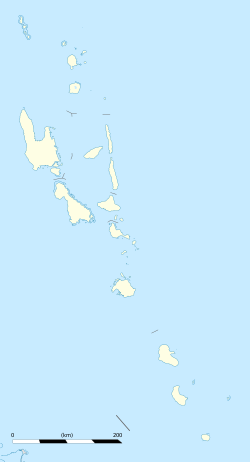Paama
|
Paama Voum |
|
|---|---|
| Island | |

Paama, neighbouring islands and main centres
|
|
| Location in Vanuatu | |
| Coordinates: 16°25′55″S 168°14′08″E / 16.43194°S 168.23556°ECoordinates: 16°25′55″S 168°14′08″E / 16.43194°S 168.23556°E | |
| Country |
|
| Province | Malampa Province |
| Population (2009) | |
| • Total | 1,627 |
| Time zone | VUT (UTC+11) |
Paama (Paama language: Voum) is a small island in the Malampa Province, Vanuatu.
The island is about 8 km from north to south and only 5 km or so at its widest point. The island is dominated by hills, rising to a height of around 550 m in the north.
Paama lies a short distance south of Ambrym, a little further east of Malakula, about 7 km west of the large active volcano Lopevi (Ulvae, in the vernacular (see Crowley 1982), and a short distance north of the island of Epi. During daylight, all of Paama's neighbouring islands are clearly visible from various locations on the island. Indeed, on a clear night the red glow of Ambrym's twin volcanos can be seen clearly from the black sand beach at Liro. The now uninhabited island of Lopevi dominates the view east from the village of Lulep, on the northeast coast of the island. This active volcano is reasonably regular, erupting every two years or so, causing quite serious problems for those living in the villages of Lulep and Luli in the northeast of the island. The acidic volcanic ash falls onto gardens, ruining crops, and onto the natangura (sago palm) thatched roofs, rotting it.
Today the majority of people living on Paama live in villages close to the coast of the island and make their gardens on the hillsides nearby. Agricultural produce is by and large for subsistence although some is exported for sale in Port Vila (Vanuatu's capital on Éfaté) and Luganville (on Espiritu Santo).
Liro, the island's council and administrative centre is the most heavily populated village on the island. The council building, standing a hundred or so metres up from the shore is said to have been the house of the Rev. Maurice Frater, the Presbyterian missionary resident on the island in the early 1900s. Frater arrived on the island in 1900, when outsiders were treated with great hostility, and stayed for 39 years, building 21 churches and converting the majority of the population to Christianity.
...
Wikipedia

